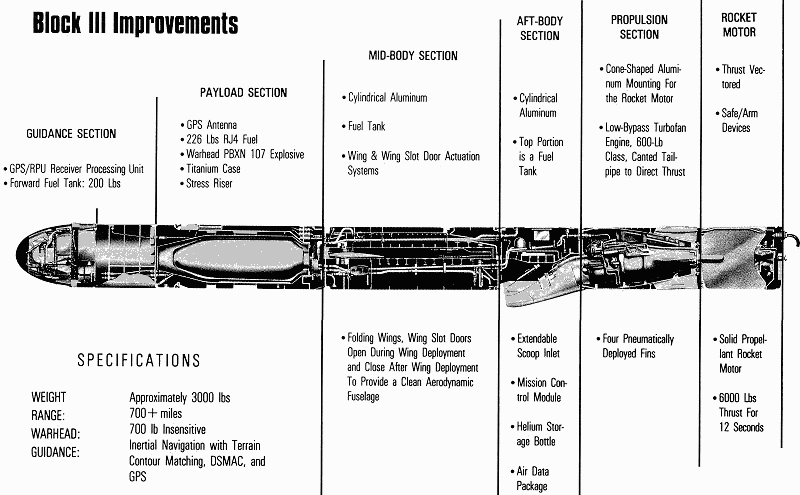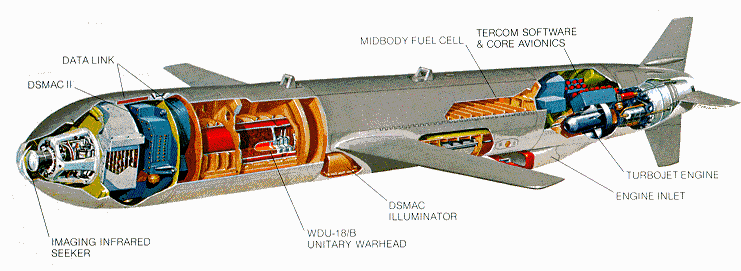Warum wird Silber verbaut in den Tomahawks? Was für Bauteile sind das und warum?
Vermutlich für die Batteriesysteme.
http://de.wikipedia.org/wiki/Silber-Zink-Akkumulator" onclick="window.open(this.href);return false;
In moodernen Torpedos wird viel Silber verschwendet.
http://www.saftbatteries.com/doc/Docume ... e175c5.pdf" onclick="window.open(this.href);return false;
In mnchen Raketen ohne Triebwerk und Generator sind auch SIlber-Zink Akkus drin.
http://www.ausairpower.net/TE-Harpoon.html" onclick="window.open(this.href);return false;
The Sustainer Section provides structural support for the missile wings and the fuel tank cavity is used to house two oneshot silver zinc batteries, once activated these provide power for the avionics.
Steht auch im Manual
http://www.fas.org/man/dod-101/sys/smar ... lam-er.pdf" onclick="window.open(this.href);return false;
c. Sustainer. The sustainer section is a modified Harpoon sustainer consisting of
a Teledyne CAE-J402 turbojet engine, cast aluminum flush inlet, a sealed fuel tank with JP-10
fuel, a silver-zinc battery, and wing roots for the air-launch kit. This subsystem is the same as the
one used in the SLAM missile. The only modification is to add the wiring to the engine fuel
controller.
http://www.spacepda.net/abstracts/01/sb ... 12320.html" onclick="window.open(this.href);return false;
TECHNICAL ABSTRACT (LIMIT 200 WORDS)
With the highest available energy of any known aqueous chemistry, Silver/Zinc batteries have found successful application in numerous NASA missions. However, severe wet-life and cycle life limitations of present cell designs restrict the mission capability of the Silver/Zinc system. Two principle causes of cell failure are: 1) degradation of the cellophane separator in contact with alkaline KOH electrolyte/Ag+ ion and 2) shape change and dendrites associated with the zinc anode. The innovation proposed here applies radically new material formulations and methods of electrode fabrication to produce extremely long-life and high energy Silver/Zinc cells. More specifically, a chemically-stable, surface-functionalized, microporous, polyolefin separator and specially formulated roll-bonded electrodes, are to be evaluated in Silver/Zinc cells. Successful implementation could prove to be a significant advance in performance (energy and operational life) in a system with demonstrated capability to operate in harsh environments, providing a high power alternative to lithium-ion batteries. In the proposed Phase I effort, RBC Technologies will work with Eagle-Picher Technologies to demonstrate expected improvements in silver/zinc cell energy, power and durability cells and deliver to NASA a Final Technical Report. RBC would extend this effort and deliver working batteries to NASA as part of a follow-on Phase II.
POTENTIAL COMMERCIAL APPLICATIONS
Silver/zinc batteries have been widely used in space where volume and weight limitations are critical. Space applications include: launch-vehicle guidance and control, telemetry, NASA vehicles, space shuttle payload launch and power for the life-support equipment used by the astronauts during EVA's. Silver/zinc batteries (primary as well as secondary) also find critical applications in military markets, powering over 90% of all military missile systems, including the Patriot and Tomahawk Cruise missiles. The Navy makes use of silver/zinc batteries in applications that include: mines, buoys, special test vehicles, swimmer aids, deep submergence and rescue vehicles, exploratory underwater vehicles, torpedo propulsion, drones, submarines, and other military equipment. There are also commercial sector applications for silver/zinc in premium electronic equipment that requires a lightweight, high-capacity battery, such as portable medical equipment, portable communications, and professional video recorder. With sufficient improvements in wet-life/cycle-life, technology developed under this SBIR program could find new markets in high performance telecommunications and satellites, which are currently undergoing high rates of growth. Higher performance silver/zinc batteries could be reasonably expected to take market share from older versions of this system, and would be a driver for implementing technology successfully developed under this program.
http://ausbullion.blogspot.com/2011/03/ ... ya-to.html" onclick="window.open(this.href);return false;
http://maxkeiser.com/2011/03/20/note-ea ... batteries/" onclick="window.open(this.href);return false;
Note each cruise missile contains approx. 15kg of silver in wiring, contacts, solder and batteries. The more silver the SLA talkes off the market, the less bombs and missiles can be fired. BUY! BUY! BUY! so they can’t bomb! bomb! bomb!

